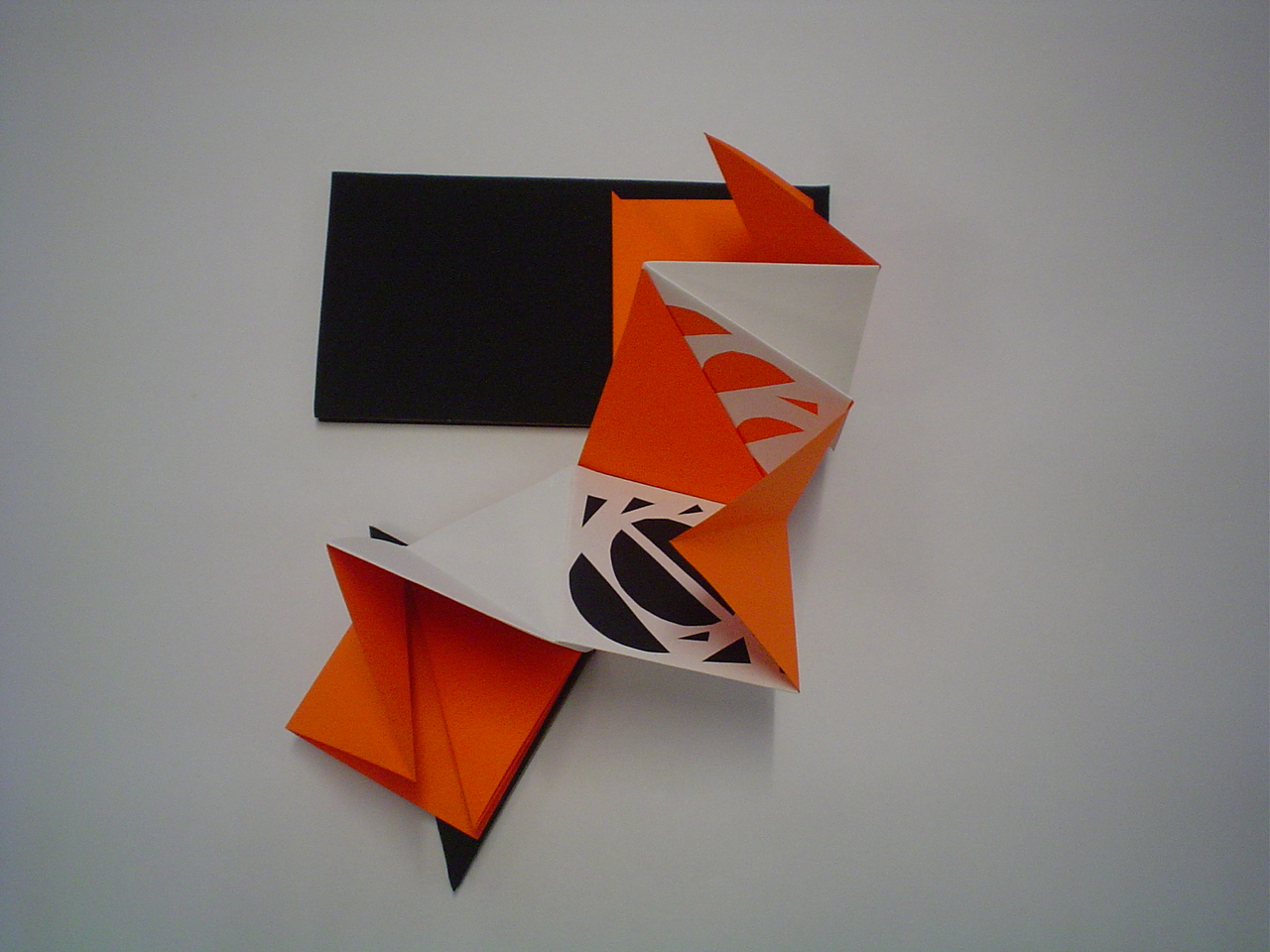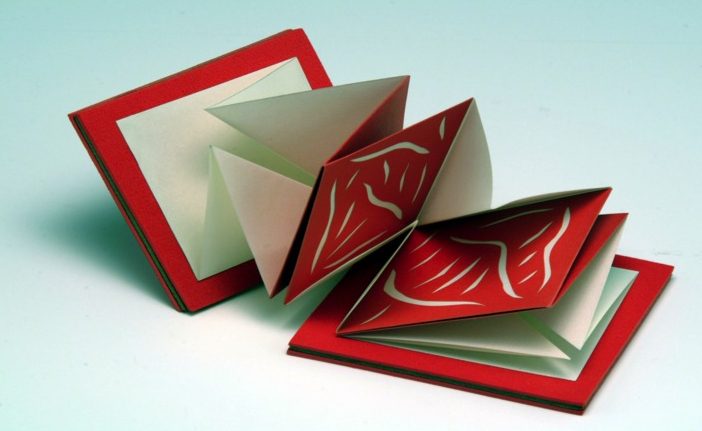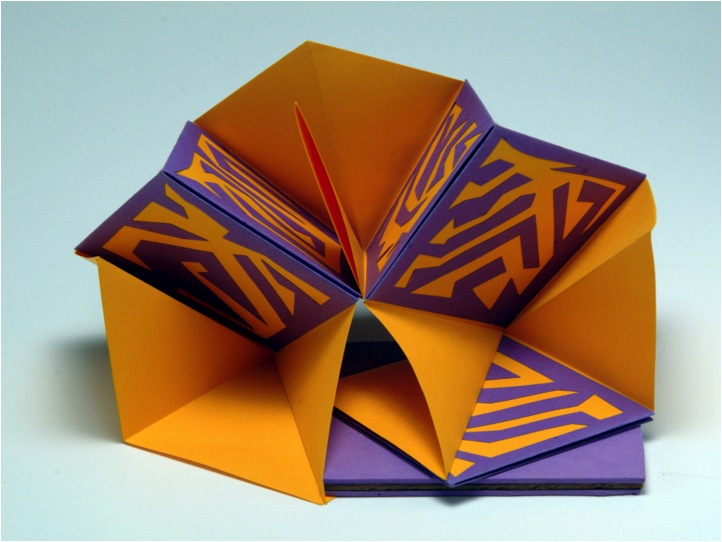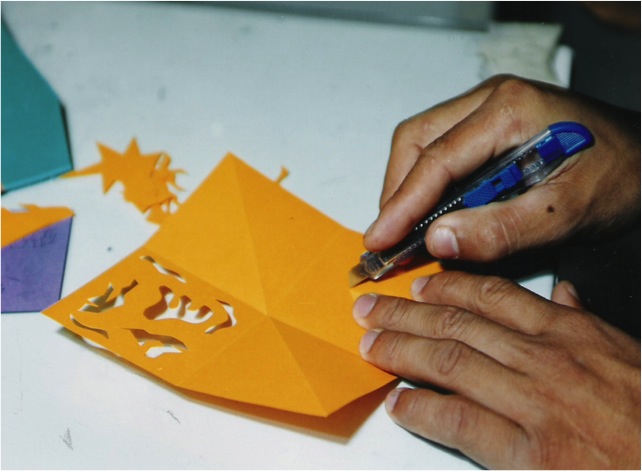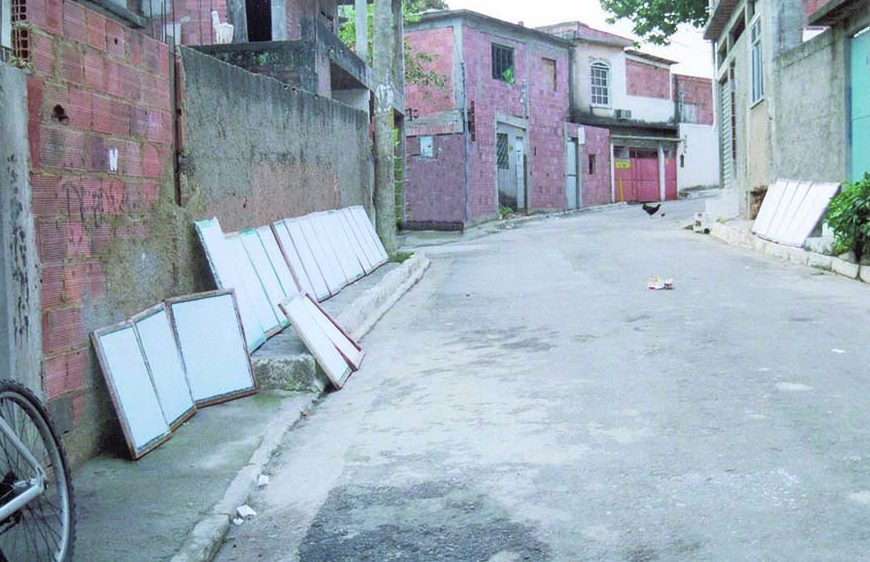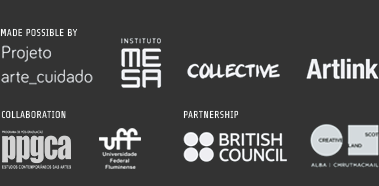
Douglas Araujo. Workshop of artisanal paper in the community of Morro do Palácio [Palace Hill], Art Environmental Action, c.2000
Multivoiced Reflections: Art Environmental Action and Macquinho
Bia Jabor, Carlos Artur Felipe, Eliana Carrapateira, Leandro Almeida, Luiz Hubner, Márcia Campos, Marcos Barreto, Nuno Sacramento and Thatiana Diniz
Editors’ Note: The following reflections interweave histories of the Museum of Contemporary Art of Niterói (MAC)’s Arte Ação Ambiental [Art Environmental Action] project, a museum education and environmental art initiative that began in 1999 in collaboration with young people in the nearby favela Morro do Palácio [Palace Hill] and the community cultural center Macquinho or “little MAC,” situated on top of the favela, inaugurated in 2008 to initially house the project’s continuation. The Arte Ação Ambiental project (1999-2014) encompassed multiple initiatives from regular discussions on art, artmaking and social museology, training in artistic handmade papers (spurred by interests in income generation which in turn led to special products being created and sold in the museum’s store), design objects inspired in the Brazilian neoconcrete art movement and artists in MAC’s collection, an alternative music lab with instruments made from recycled materials that led to the creation of the band “Sonorizar,” writing workshops and a community newsletter, theater, graffiti sessions and more. Awarded a major grant by BNDES [Banco Nacional de Desenvolvimento Econômico e Social – National Bank of Social and Economic Development] to construct a community arts center in Morro do Palácio that could serve as the project’s “headquarters,” the socially engaged art initiative won the heart of Oscar Niemeyer (also the architect of MAC) who made “gifted” a design for the center. Macquinho was to be the first “modulo de ação comunitária (m.a.c.)” [module of community action] inspired in the distributed clinical network of “modules” of the Cuban-inspired residential preventive health initiative known as the Programa Médico Família [Family Doctor Program]. Its first active years as a community center were challenged by municipal administration changes, lack of resources and construction issues caused by heavy rains and threats of landslides. In 2014 Macquinho became Niterói’s first Digital Urban Platform now under the jurisdiction of the Secretary of Education, Science and Technology. Many individuals, organizations, institutions and community collaborations were and continue to be involved in this educational “star” as the artist Almir Mavignier described Macquinho. These reflections offer a lens onto some of the histories that have shaped it. Many others could be included and we hope that this initial collection of multiple voices spurs additional contributions.
Workshops for Artistic Creation and Neoconcrete Games
Bia Jabor
From interpretative experiences with works of geometric abstraction from the concrete and neoconcrete art generation of the 1950s and 60s in the MAC’s collection, considered the vanguard of Brazilian art, emerged a key strategy of the museum’s educational practice – neoconcrete games. Works by artists such as Hélio Oiticica, Lygia Clark, Hermelindo Fiamingui and Ivan Serpa, inspired games of creative fluency. Using reproduced geometric shapes and forms “freed” from the canvas, spectators/participants could both mirror the abstraction of the works on display and/or play with new combinations, composing infinite possibilities and constructive variations as did the artists of this generation.
What had moved the artists of the 1960s was taken as an inspiring basis for the philosophy and practice of the neoconcrete games, constituting above all strategies of active recuperation of artistic processes (i.e. re-experimentation of the concepts, techniques, choices the artists themselves explored), affection and communication with art. This educational / interpretive strategy, starting with the very first exhibitions of the MAC in 1996 and developed by the museum’s art education team, was introduced early on into the workshops of the Art Ação Ambiental project in 1999, at the time coordinated by Luiz Guilherme Vergara, then director of art education. As a member of the team, I followed the development of this project and saw the transformation of the group of young participants, who were gradually rediscovering the world through color, shape, composition and creation – through games. From 2002 to September 2004, I took a more active role with the young participants of the neoconcrete games workshop, continuing the work that had already begun. It was a process of much exchange and collective construction. More than teaching, I learned. My role as an artist and educator was much more that of a proposer of experiences, of provoking situations, and of putting art into action. Via a direct and prolonged contact with original artworks in the museum’s collection we wanted to give these young people an opportunity to meaningfully experience contemporary art and artistic processes. Our goal was to explore ways of seeing and develop the critical capacity of the young participants through strategies of qualitative access i.e. one on one interaction and deep immersion in experimental artistic processes that sought to make relational connections with their everyday life, the city, the museum and contemporary art. It was a long process of dialogue with the artworks including experimentation with different materials, studies of color, drawing and much conversation. What made their work fascinating was precisely the fusion of the “learned” art language with the ethical-aesthetic references they brought from their lives, creating, without the (pre) concepts of art history, visual solutions that were completely new.
Memories of the Beginning of a Holy Madness: Arte Ação Ambiental
Carlos Arthur Felippe
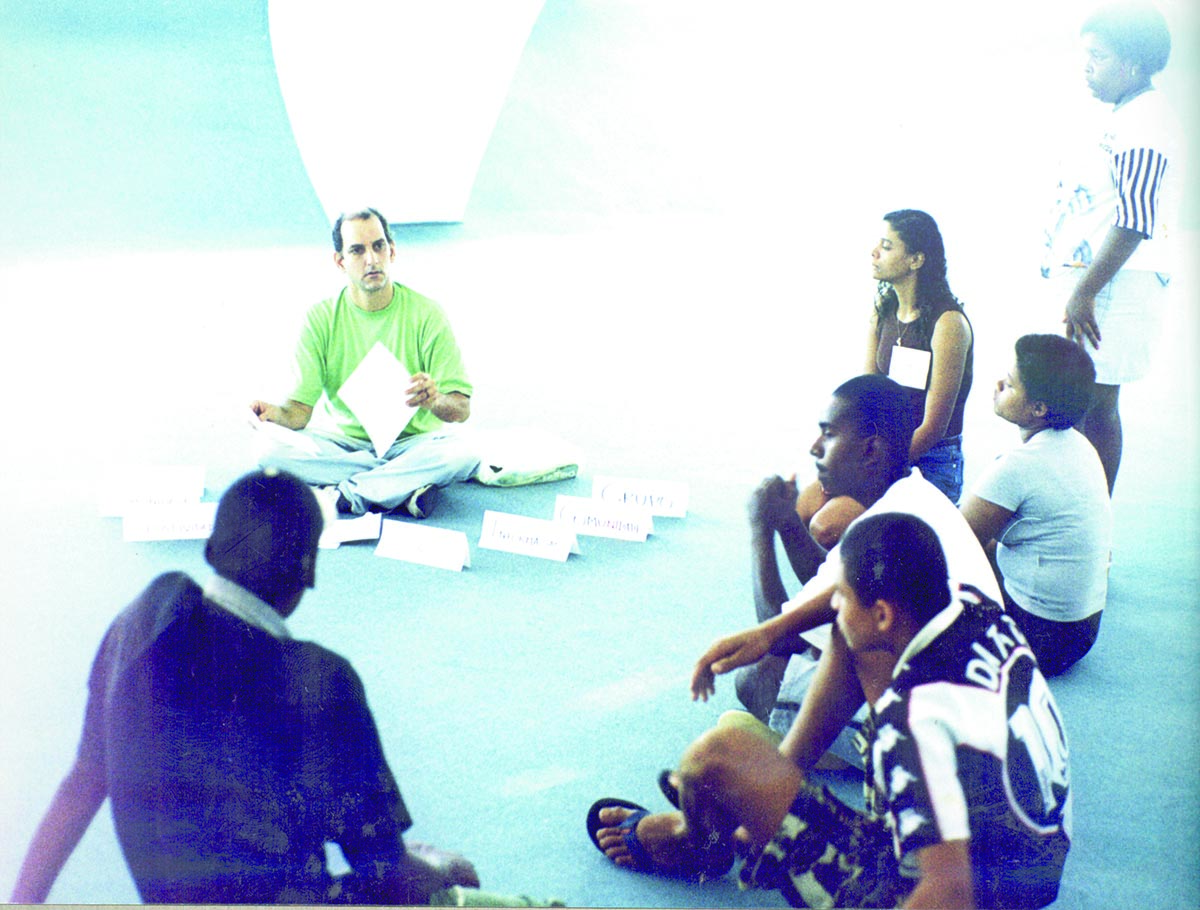
Carlos Arthur Felippe. Arte Ação Ambiental workshop, MAC Niterói, c.2000.
And I already have the name: Arte Ação Ambiental! My friend Guilherme Vergara, then director of art education at MAC Niterói, said with enthusiasm, his eyes shinning. He had called me there to get involved in this holy madness: to invite some 40 young people from the neighboring favela Morro do Palácio to be part of an ongoing educational project between the museum and community that would join art, sustainability and social action. Madness because MAC was, and still is, one of the most sophisticated spaces in the city, with modern art exhibitions rivaling the best in the country and the world. Designed by Oscar Niemeyer, it welcomed national and international celebrities and served as the setting for global advertising campaigns. How would these young people, favela’s dwellers, behave in this environment? We did not know them, and most of them did not know the museum. This is just to say it was not easy …
We had no references. At the time there were few projects merging art, sustainability and social action in museums, or even in any other contexts. Although we wrote endless versions of the project in attempts to raise ever unattainable funds, we did not have a structured pedagogical project with defined objectives and methodologies. But no one there was very worried about this …
We had the support of the then director, Dora Silveira, who had a lot of trust in Guilherme, and we had the shape of a still emerging team that was getting to know each other. Artists and environmental educator Eliane Carrapateira, there from the beginning, had a few contacts with the president of the Morro do Palácio’s residents’ association, and with that, we crossed the street, we climbed up the hill of the community and we went about handing out some very makeshift flyers, inviting young people for a selective process of a few days from hence.
On the appointed day, almost 50 young people showed up. We divided them into subgroups so that they could get a sense of the project proposal in practice and evaluate whether they had a real interest in starting this process. A few soon became disinterested, and it was not too difficult to define the group of the initial 40. Curiously, the next day, I was told that there was a young man from Morro do Palácio at the entrance asking to speak with me. When I got there, first I should say that I am six feet tall, I had to move my head up, at a wide angle. Do you know those big floor to ceiling closets that have space for suitcases? The boy was wide, tall, very big, with strong arms, and his skin was black, almost blue. Very calmly, in a soft voice, he asked for a place in the group. I replied, explaining the selection process, saying he did not come on the right day, that he would need to wait for another opportunity etc. At the same time I was thinking: if he wants to, he can become the leader of the group just with his arms, it’s going to be a problem, you’ll regret it … But there he stood with peaceful eyes, and just said, as if reading my thoughts: “Please give me a chance, you will not regret it…” I threatened him with summary expulsion on the very first problem, that I would keep an eye on him etc. But I accepted him, sure of having made a stupid decision. I did not. Almost 20 years of these stories have gone by, the project lasted a long time, became Macquinho (that’s another story) and the 40 young people dispersed, fulfilling their destinies. But he could still be there, since he was one of the few (if not the only one) to become part of MAC’s staff, because of his qualities, commitment and extremely generous character. Remember that, Marcão?1
Handcrafted Artistic Paper Workshops
Eliane Carrapateira
I look on Arte Ação Ambiental project as a beloved child. I participated right from its inception in 1998, supported by the Morro do Palácio residents association and, initially, by a governmental initiative in low incomes communities called the Community Solidarity Program. The project was like a child who, with certainty, had the potential to grow into much more then their current circumstances allowed. Born of the dream of providing practices of transformative action of the reality of social inequalities, through art, culture and education, the project aimed to find ways to bridge environmental concerns and young people of the Palácio community. It was a joy to be part of a team that had, among its objectives: stimulating the development of the potential talents of the students; creating an affective environment of coexistence and learning; accessing new knowledges practices; and increasing self-esteem. It was a joy that over a ten year period we were able to work in our work together via artisanal handmade paper workshops (Oficina de Papéis Artísticos Artesanais [Workshop of Artistic and Artisanal Papers], 1999-2009).
It was a joy to have managed to attain most of our goals. From those early years we created a handmade paper team comprising those young people that joined the project in 1999. Once trained together we created exclusive products for commercialization and, above all, began to multiply our actions in Palácio itself and in many other contexts, offering workshops in the community and in colleges, museums, private companies, NGOs and others. This team, made up of the first participants in the Arte Ação Ambiental project become of special importance because the young participants decided that it would be good to dream the same dream that we had had at the beginning; to adopt this “child” as theirs also. They continue the actions of OUR workshop and many others of which they are part by seeking to transform, TOGETHER, the dream into reality, believing in the work as a means of social inclusion. These young people have the merit of resistance, of persistence.
I see, therefore, the Module of Community Action (Macquinho) as what it is: the desired, idealized HOUSE/HOME dreamed for so long by the whole team of the Arte Ação Ambiental project. Now open to the entire community, this “house/home” makes its activities and actions available for the integration and growth of those who are willing to get involved. A space where educational and artistic proposals can expand through as many languages and expressions as possible; a dynamic and playful way of combating prejudice and inequalities that seeks to provide the chance for new knowledge where new talents can flourish. A process that works toward better, more confident, competent, responsible and participative citizenship. A generative place of new unique products and processes for those who appreciate art made by hand and heart. As an educator, I think that this kind of path is a key to developing the talents of each participant, and as a visual artist I think art is an ideal vehicle for the development of these potential.
I end with an expression of gratitude to the extraordinary people who were part of this process and our workshop, for the work, personal growth and conviviality that we share. To name a few such as: Janete Loreto de Sá, Rodrigo de Oliveira Paes, Kátia Alvez, Ronaldo Affonso, Guilherme Vergara, Josemias Moreira Filho, Elielton Queiroz Rocha, Douglas Araújo, Maurício Souza da Silva, Márcia Campos, Luiz Hubner and also some of the alumni such as Carlos Alberto Cardoso, Daiana F. da Silva, Erasmo, Fernando de Almeida Lopes, Leandro Gonçalves Silva, Lucilene da Costa, Luiz de Jesus, Marcos André Silva dos Santos, Michelle Lima Pires, Paulo Sérgio M da Silva, Ricardo Cristiano Constantino, Carlos Alberto dos Santos Oliveira, Edeilson Rosa da Silva, Diogo Conceição de Oliveira, Jonathan Oliveira, Carlos Alexandre da Conceição, Wellington Soares da Silva and others who contributed to professionalism, hope, ART and JOY!
Cultural Citizenship, Education and Art…
Leandro Almeida
When I arrived at MAC in search of an internship in 2002, I did not imagine that I would have the possibility of experiencing cultural production in such a special way, associated with education and humanity. There I encountered the Arte Ação Ambiental project. Inspired by this invitation to reflect, I put together this brief report on the human and professional growth I was fortunate to experience over my eight years with the project.
MAC’s outreach program was a pioneer in the field of developing comprehensive community based museum education practices. Between the museum and the Morro do Palácio favela, so close geographically, but so distant socially and symbolically, an inaugural path of mediation was constructed.
The museum’s architect Oscar Niemeyer described MAC’s winding red ramp as providing a red carpet of for everyone. Through the Arte Ação Ambiental project this path acquired even greater scope by diluting a symbolic barrier between perceptions of “them” and “us.” The museum’s art education department and the community of Morro do Palácio came together to experience art through favela alleyways and red-carpet like ramps establishing a network of connections.
As the executive coordinator of this project, I strove to affect a territory of educational propositions and actions via cultural production initiatives that connected local cultural manifestations with concepts and practices present in the artworks of the museum’s collection. These “cultural productions” are tools of action for discovery and potentialization of knowledge, establishing a methodology of thinking about art and culture as a relational field of learning.
In order to facilitate such exchanges, it is necessary to get to know other worlds, to challenge social perceptions and prejudice, embrace diversity, understand questions of exclusion, seek solidarity. So my main role before planning, assessing the feasibility of particular activities or even thinking about the artistic languages that might be used, was to mediate intentions.
Over time the educational work of the museum together with the community became an exchange of learning and collective development, forming a kind of ongoing practice based learning process. Weaving understandings without imposing intentions or disrespecting the local reality was my biggest challenge.
Memory, cultural citizenship, education, art and society merged through a series of practices developed with the community, among them: artistic workshops, environmental education, audiovisual experiences, community journalism and artistic interventions. Project participants, directly or indirectly, tuned into a process of the construction of narratives that embraced awareness, knowledge, growth, dreams, rights, protagonism, belonging, income generation, citizenship and reflections on the world; this was very gratifying.
The much-desired indicators demanded by sponsors and social responsibility bodies were not tangible or quantitative. We were witness to changes in subjectivities, to above all, shifts of qualitative importance. How do we measure the change of someone’s posture to the life? How to measure instilling the possibility to desire, dream and make plans? These were some of the things that I experienced in this project where I made friends and relationships of respect. As one of the participants in the project defined it, Arte Ação Ambiental is: “JOY IN THE FORM OF ART.” This is the definition I carry with me. Today, when I recall the project and experiences I had, I think about and reconnect with that feeling of “joy in the form of art.”
Family Doctor Program: A Commitment to the Construction of New Subjectivities
Luiz Hubner

Graffiti wall in Morro do Palácio. Arte Ação Ambiental, c. 2005.
With the 1988 Brazilian Federal Constitution [after more than 20 years of a military dictatorship] a new public paradigm [of access and expansion] emerges, one that understands health as a quality of life. Here, a new approach to health problems is based on their social-historical determination, that is, working with communities toward a preventive political practice of sanitary awareness; one that fosters a social conscience that in turn promotes social transformation. Such a paradigm presupposes a profound revision in the organization of public health. Work practices that previously were structured around the centralizing model of receiving the “sick,” shifting to residential nomadic practices focusing on the territories where people live, where life happens. This process demands a constant search for partnerships intersectoral, construction of new knowledge, new subjectivities, new existential territories, through the co-production of health with quality of life. Territory encompasses the space where social groups live, their relations and conditions of subsistence, their work, income, housing, their access to education and preexisting knowledge. All these factors are integral to a socio-cultural environment and conceptions about health and illness, family, society, etc.
In 1992 the city of Niterói implemented a new public health initiative called the Programa Médico Família (PMF). Niterói, like other Brazilian cities, is characterized by a deep fragmentation between classes, comprising urbanized neighborhoods inhabited by high income populations and bordering hills occupied by mostly low income populations with extremely precarious infrastructure – the later territories are the focus of PMF’s work. In these contexts violence can be observed as a social symptom that emerges in very structures of how people live and occupy the city in a globalized capitalist world. Such a contrast brings us face to face with the complexity of contemporaneity that even while creating discourses to combat violence is also capable of reproducing it incessantly and simultaneously. A tragic example of this is the constant violent encounters between police and / or paramilitary groups and the illicit drug trade in the vast majority of Brazilian “favelas”, often disrespecting the resident working population that has so often fallen victim to this war.
MAC was a constant partner in the struggle to create new realities for the community of Morro do Palácio. I speak here of the power of providing the access to art as a key to the construction of new subjectivities, new life potential. Starting in 1999, MAC, the Family Doctor Program and Morro do Palácio resident association began to build fruitful partnerships through initiatives that combined art, health and community for mostly young (adolescent) favela residents. The great majority of “social projects” focus on the development of the skills necessary for the insertion of this population into the labor market; addressing income generation and employment opportunities, no small matter indeed. However, since beginning the Arte Acão Ambiental project aimed for something more. It rather focused on the potential relationship between cultural spaces and the conquest of citizenship as a practice of dis-alienation. The project sought to promote experiences that supported the potential of individual growth emerging as part of a reciprocal territory of contagion in between art, culture, education, health and citizenship. The focus was to detect new modes of subjectivation emerging in communities, new collective statements, existential territories, group intelligences that escape the capture of capital and that do not yet have visibility in the repertoires of our communities, of our cities. This was the calculated risk of this project.
Expanded Education: Trajectory and Processes
Marcia Campos
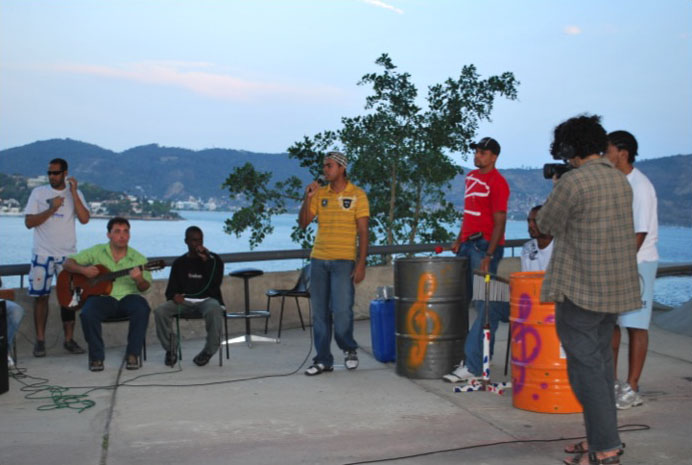
“Sonorizar” [To make sounds], musical group of the Arte Ação Ambiental project, performance on the patio of MAC of Niterói, 2008.
The work of social agency of the Arte Ação Ambiental project together with the community of Morro do Palácio, was initiated in the first years of operation of the MAC with the participation of a group of artists and educators, moved by common ideals, under the coordination of Luiz Guilherme Vergara.
Workshops related to the field of art and environmental education were carried out inside the museum and in different spaces in the community of Morro do Palácio, even in people’s homes.
Guided by relations of affection and care, the project was fundamentally important as a means of supporting the transformation of young people, many of which had never entered an art museum.
As more encounters took place, their familiarity increased with both the context and its distinct architecture. Slowly transformations became apparent. The conviviality of the group became more cordial, people got closer and more participative. A new universe of paths and possibilities of individual and collective transformation was opened.
The potential of project motivated the construction of its own headquarters, which was to be the Module of Community Action of the MAC of Niterói, with a project created by the architect Oscar Niemeyer and the construction sponsored by the BNDES and Niterói’s municipal government. With the inauguration of the building popularly called “Macquinho”, at the end of 2008, the second phase began: the project became a Module of Community Action.
Under the management of the Division of Art Education the MAC of Niterói (itself managed by the Niterói Art Foundation (FAN)) [from 2008 – 2013] a non-formal education program was established. Despite the [lack of resources] and the many challenges and difficulties encountered, the enthusiasm of young people, the idealism of educators-artists and institutional partnerships, made it possible to explore the expansion and structuring of new frontiers and programs, with broader participation, attracting children, young people and the elderly in the community, who started to attend the new space “Macquinho”.
We strove to continue the workshops such as games of artistic creation inspired in works of the João Sattamini collection at the MAC, workshops of handmade artistic papers, of musical training with the band “Sonorizar”, and of silkscreening. Here it is important to mention for their partnership and support: Municipal Education Foundation; Universidade Federal Fluminense; the artistic residence program of INOVART (Ministry of Culture of Portugal); “Farol Cultural” Project, exchange of Brazilian and Norwegian artists sponsored by the Ministry of Foreign Affairs of Norway; cultural media and youth training organization “Me Vê na TV”; the NGO Campus Avançado and the Brazilian National Arts Foundation (FUNARTE); and the silkscreen workshops, with the participation of the collective Radical Urban Silkscreening Team (RUST) supported by The Andy Warhol Museum.
Macquinho completes a decade of existence this year in December 2018. Many projects, programs, partnerships and institutional connections have been implemented. The legacy is implanted and offered to the community of Morro do Palácio.
The project Arte Ação Ambiental did not transform the reality of all the young participants, but it contributed to the formation of participative citizens who value and interact with the culture of the community to which they belong, prepared for a more responsible, creative and critical action in society.
Care as Methodological Inspiration
Marcos Barreto

Public workshop of the project Arte Ação Ambiental, c. 2005.
Beginning at the turn of the century, MAC’s Arte Ação Ambiental sought to initiate a dialogue with the youth of Morro do Palácio, the favela community near the museum and vulnerable in social and environmental terms. Care was fundamental to the methodology of working with the young residents of the community: not to determine a priori what would be the socio-environmental actions of the project that sought anchorage in the community. Listening to community demands, especially those of young people, was an invaluable methodological care for the project to take form and generate productive actions with/for its participants.
It is impossible to forget the refusal of one of the participants to accept the characterization of “carente” [T.N needy – a term regularly used to describe low income populations] used in one of the initial meetings to define the set of privations that characterize the favela populations of our country. Expressing pride in his family, friends and community, the young man spoke of love, solidarity and local knowledge, deconstructing, with the support of other colleagues, the place of submission of the “needy” to the “civilized.”
It is also worth noting, in the context of this dialogue, one that was always promising but marked by disagreements, the visible discomfort of the technical staff of the museum, not directly involved with the project, with the somewhat noisy presence of teenagers and young people, not accustomed to the quieter atmosphere of museums. The dialogue required a mutual learning, where everyone is educated to understand diversity and the other.
The care with the quality of the relations between the participants of the project — the artists and coordinating educators of several workshops and the young people involved — translated over time into the care with the quality of the work that was produced. The workshops of neoconcrete games, handmade artistic paper, music, creative writing, journalism, drawing, silkscreening, environmental education and earth/land workshops e.g. garden projects in the community, developed as rich training experiences in various fields of knowledge, not only for the young people of the community who participated in the project, but certainly for artists and educators, as they had a rare opportunity for professional enrichment in an environment of collective construction.
Returning to the notion of care as a methodological principle, we can say that in the case of MAC, the museum transcended the traditional mission of guarding and taking care of a collection for the usufruct of its users, generally belonging to the most intellectualized segments of the population. In this experience, in which I had a modest participation, a museum dedicated to contemporary art, with little appeal to attract so-called “needy” populations, became an unusual space of articulation of educational, aesthetic, environmental and cultural interests. One that was capable of producing actions that resulted in the construction of an extension of the MAC in Morro do Palácio, a Module of Community Action, known as Macquinho to house the various aforementioned workshops.
We can see here the potential of a museum, a public cultural institution, whose socially interested care with its surroundings, resulted in the creation of another cultural space, nourished by an experience that will hopefully continue to mobilize the collective care of artists, technicians and educators supported by the museum, and the youth and other residents of Morro do Palácio.
The Mesa Baldio Project
Nuno Sacramento
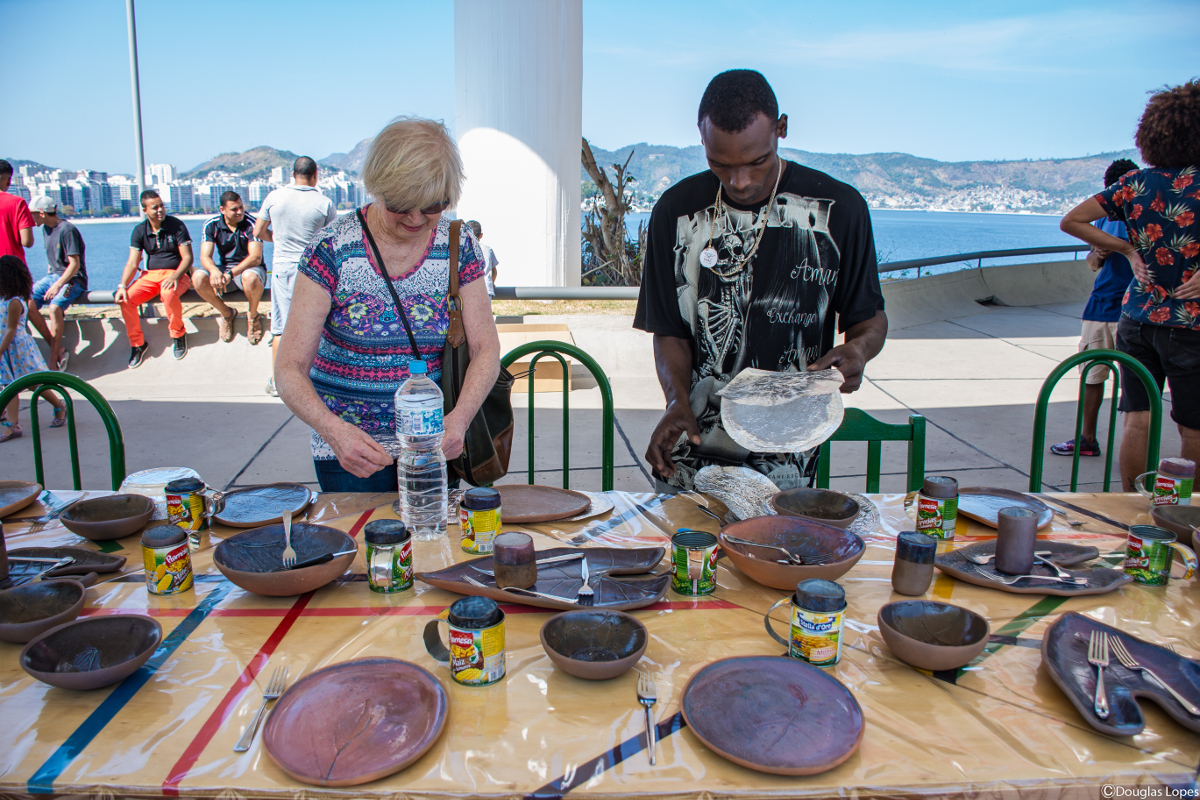
Mesa Baldio, 2016. Photo: Douglas Lopes
I.
I grew up in a house without pictures, without art. The white walls, yellowed by tobacco smoke, stripped of any image, lay bare. Later, I moved away from the Catholicism within which I was raised and became a Protestant, Presbyterian. The Presbyterians are the Church of Scotland, where I moved in 1997, at the age of 24. This, like other Protestant churches, is famous for its iconoclasm. The visual richness of the Catholic church, with images of saints, painted ceilings, and gold altars, gave way to bare walls. For me there was nothing new. It was familiar.
II.
I live in Scotland today, in a house with yellow walls and no smoke. With hesitation, we put some posters on the walls in order to make the rented house a bit ours. One of these posters, in the entrance hall, is a poster of MAC, Niterói.
This poster features a panorama taken with a wide angle lens, showing the beaches of Icaraí and Jurujuba, Pão de Açúcar, Côrcovado and Ilha de Boa Viagem, and there in a prominent place is this UFO, MAC with its red ramp, overlooking Guanabara Bay.
III.
From the first time I went to MAC, I heard the story of this red carpet ramp, which rises in a swirl in front of the museum, a red carpet that invites the VIP visitor for a unique architectural experience, a 360 degree view of the bay. It was under this same ramp that I had one of the richest experiences in life. Tables, dishes, glasses, placemats, and food, all made by young people from several different neighborhoods of Rio and Niterói (Maré, Palácio, Gragoatá, Gradim and Bumba) served a banquet, our Mesa Baldio, where more than 100 guests – artists, security guards, cleaning staff, and even museum visitors – shared a banquet. [T.N. Mesa = table, baldio = in Brazilian Portuguese generally used as a adjective as in “terrenos baldios” meaning wasteland, abandoned land or city lots. A suggestion here of the “common” possibilities in abandoned contexts.]
IV. At the end of the day, we arrived at Morro do Palácio where a party was taking place. Suddenly, “Telto” Queiroz, a talented musician and writer from the community, sung:
Rap of improvisation I arrive
soon and stop I opened my eyes
now from everything you see
and I foreseeIt’s one that looks better there.
Jefferson “camelo”
filming everything on go-proThis is challenge of the
meaning of the word
baldio [T.N.wasteland]Collectivity comes
to mind, something
unfortunately missing
in society to take care of what
we all in some way
favela is a plant
selective collection favela plants
planting the active voice
baldio is our boss,
The baldio encouragesIt is necessary to change habits
and customs stop talking
s **** and produce fertilizer
with manure and not only
think woman
new car and perfume I think
in a better world
making fertilizer out of garbage
let me fly on the wind
on the moment Nuno Sacramento
assumes life is a
mountain I want to get
to highest peak
V.
Situated on the top of Morro do Palácio is Macquinho. On my posted it is to the left of the image and out of the frame. Usually the favela and its inhabitants are out of any tourist image of Rio de Janeiro. But in culture it’s different; the MAC / Macquinho axis, linking Niemeyer’s two projects in one cultural, educational and environmental action program, tried to bring the favela to the museum and the favela museum. It was on this axis that our project Mesa Baldio was positioned. And the thing really worked. It was not a project for “para inglês ver” [T.N. Literally for the “English to see” – an expression referring to things just put on for show]… Experiences were exchanged, much was learned, friendships were made, categories were mixed, turns were changed. There is not a week that passes that I do not remember the groups of young people with whom we worked: Maicon Santana, Maicon Rodrigues, Matheus da Silva, Otávio Henrique da Silva, Josemias Moreira Filho, Elielton Queiroz Rocha, Ezequiel, Patrick Sousa, Marcos Vinícius , Douglas Araújo, Lucília S. Santos, Rayssa Araujo Batista, Loran Santos, Leonardo Campos, Natanael de Oliveira da Silva, Lucas Barbosa dos Santos, Gilson S. Jorge, Priscilla Ferreira, Rogério da Silva Brunelli, Raiany Bispo Soares, Tuany Felix Freitas, Rubes Izidoro Blanc, Raphael Vasconcelos Rodrigues, Sandra Cátia de Souza, Vanderlani Cavalcante da Silva, Angela Ricardo, Hericleyde da Silva, Fernanda Dutra, and Ana Carolina da Costa Rodrigues.
VI.
Today, this MAC poster has expanded. In it fit all those names and experiences that make Rio and Niterói one of the places that I call home.
The “Palaciano”: A Project Towards the Democratization of the Media
Thatiana Diniz

The “Palaciano.” Morro do Palácio community newspaper, 2005
The areas known as “favelas” are commonly cited in the news only when they become the scene of social conflicts and tragedies, such as floods and landslides, or recurrently in the section on police reports, portrayed as a scenario of war between gangs of drug dealers and security forces.2
Aware of the urgent need to change this framework, we took on an initiative to launch a community newspaper in search of initiating an understanding of news media that as Professor Jorge Kanehide Ijuim teaches, “should be an instrument for the population to present their demands, claim their rights, raise their flags, and say: I exist!”
We sketched the first ideas for O Palaciano in March of 2004. The newspaper was going to be about the community of Morro do Palácio, in the district of Ingá, in Niterói. We were focused on raising citizens’ self-esteem by revisiting the history of this community and disseminating information on local events and telling stories about the curiosities of the daily life of its residents, sharing the kind of news that never reach the pages of the mainstream press. The involvement of the community was key and they even choose the name of the newspaper, decided in a popular plebiscite.
“Palaciano” was one of the actions of the Arte Ação Ambiental project, an educational program of the MAC that had been facilitating workshops with teenagers in the community since 1999. The project was eventually absorbed by the community center Macquinho, a space built on the top of the Morro with an architectural project by Oscar Niemeyer inaugurated in 2008. My participation in the project began in 2003, when I was invited by Professor Cristina Chagas to assist her with a number of writing/text workshops she was doing for the project. The invitation came after an interview I made with her for [Niterói”s] newspaper O Fluminense, where she worked as a reporter. Because of my focus on communications and media, I decided to work with them on the preparation of the journalistic texts, encompassing techniques of essay writing, interviewing and journalistic ethics.
In this process, two things surprised me a lot: the speed with which they assimilated the concepts and, more than anything, the negative point of view that had in relation to the press. Among their criticisms was the prejudiced and stereotyped way in which the favela and its residents are portrayed in the media. From this observation, we had the idea of elaborating a newspaper created by them and for them and the “Palaciano” was born in January of 2005. I coordinated the production and preparation of the newspaper together with five young people from the community, between the ages of 20 and 24 at the time. Thus, in addition to disseminating information, “O Palaciano” also became an instrument of extra-curricular activity, since the youngsters of the editorial team also had classes in writing, reporting and critical reading techniques. Aiming to engage these young people and potential future reader, with the editorial process of the newspaper, the “Palaciano” was also a means of familiarizing this public with the printed vehicles of communication in general.
The newspaper only published three issues but left an important legacy. More than transmitting information, it has revived ideals, revealed talents and created in each one of the young people who participated a greater awareness of citizenship.
***
Bia Jabor
Bia is artist, educator and educational curator, with more than 20 years of experience, working on idealization, implementation and project management in the area, children’s education, training programs and consultancies. Graduated in Licenciatura in Artistic Education with Hab. in Plastic Arts, by FAAP / SP. Entrepreneurial partner of the new space of art, education and movement, Casa 38. Among the works is the consultancy for the Eleva School for the curriculum of visual arts of the college that inaugurated in 2017. From 2008 to 2015 was Home Art and Education Manager Daros, responsible for the educational curatories of the exhibitions, for the art and education programming and coordination of the Child Education Center of the institution. From 2004 to 2008 she was director of the Education Art Division of MAC / Niterói and a member of the museum’s art educators team since 1998. In 2007 she implemented and coordinated the educational program of the Museum of Telecommunications at Oi Futuro / RJ.
Carlos Artur Felipe
Environmental educator
Eliana Carrapateira
Environmental artist and educator
Leandro Baptista Alemeida
Cultural Producer and Executive Coordinator of the Art Environmental Action Project (2003-2009) Cultural Producer by Uff (2007) with specialization in EAD by the Lab of New Technologies of Education of Uff (2016). He has a degree in Film Direction from the Cinema School Darcy Ribeiro, as an educator in the field of audiovisual and as a content producer. He has experience in coordinating socio-cultural projects and curating film shows. Cineclubista, photographer, cinematographer and videomaker. He is Managing Partner of Provisional Permanent Cultural Productions.
Luiz Hubner
Graduated in Dentistry from Fluminense Federal University (UFF), in 1980. Specialist in Health Services Administration from UFF (1986); Master’s degree in Social Dentistry from UFF (1998) and PhD in Sciences from the Federal University of Rio de Janeiro (2012). Professor at Fluminense Federal University since 1983; works as a professor in the department of health planning of the Institute of Collective Health / UFF. He served as Coordinator of the Family Medical Program Niterói – Municipal Health Secretariat of Niterói until December 2012. He was Undersecretary of Basic Care of Nova Friburgo during the year 2017. Experience in Distance Education (EAD) where he acts as coordinator pedagogical and regional coordinator in courses of Updating and Specialization for municipal managers of SUS, a partnership of the UFF and the Ministry of Health. Training and action in the area of Collective Health (Family Health, public health policies, micropolitics and health care). Acting in intersectoral projects in health education and contemporary art in periurban communities.
Márcia Campos
Education in Art and Education – EBA / UFRJ. Master in History of Art from the Federal University of Rio de Janeiro. Professional relationship with the Municipal Education Foundation of Niterói. She has worked as an educator at the MAC of Niterói since its foundation, having assumed the coordination of the Education Art Division between 2010/2015 and the coordination of the Community Action Module (MACquinho) in 2008/2013.
Marcos Barreto
Graduated in History Degree from Fluminense Federal University (1982), master in Education (1991) and doctor in Education (2007) also by UFF. He was a professor at the Faculty of Education of UFF from 1999 to 2016, dedicating himself to the themes of Teaching History and Environmental Education. He works as a teacher in the Professional Master’s Degree in History Teaching (PROFHistory), since 2015.
Nuno Sacramento
Born in Maputo, Mozambique, he now lives and works in Aberdeenshire, where he is director of the Scottish Sculpture Workshop in Lumsden. He is a graduate of Apppel’s curatorial training program and holds a PhD in Visual Arts from the School of Media Arts and Imaging, Duncan of Jordanstone College of Art and Design, Dundee. It addresses issues related to the feasibility of small arts, land and rural affairs organizations, skills-sharing and collaboration, Arts and Crafts in the 21st century and the commons. He is a researcher, project curator, writer and speaker.
Thatiana Diniz
Journalist and Coordinator of the newspaper “O Palaciano” and the community journalism workshop at Morro do Palacio
________
1 Marcão completed a technical course in electrical installations. After a long experience with the maintenance team of MAC Niterói, managed to be hired by FIOCRUZ, where he has his professional position guaranteed.
2 Comment by Thatiana Diniz opening the text with Jorge Kanehide Ijuim. “One of the principles of journalism says that” the reader is the beginning and the end. ” However, the concept quoted by Jorge Kanehide Ijuim in the article “The challenges of a newspaper in the community” – is rarely taken into account by the media.



